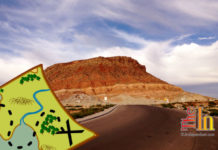
Sure, you may know that the boxes on the floor in front of a guitar player modify the sound of the guitar. But do you know the fundamental types of effects that they provide and how they are used in today’s musical landscape? On the outside chance that you may want to actually hear what these little boxes do (once and for all), we are providing you with a layman’s explanation and a few sound bytes to make the point. If this is old hat for you, please excuse while I try to help the uninformed. (Guitar players, just humor yourselves, ok?) As I explain, let’s organize our search into broad categories.
Compression
This type of effect raises the volume of quieter sounds and lowers the volume of louder sounds. Guitar players occasionally use it to even things out to impose a singing quality to solos and smooth out accompanying chords. Beyond that, compression (and limiting, which doesn’t increase quiet stuff but decreases loud stuff) is used extensively on vocals, bass, drums, percussion, broadcast announcements, and—above all—mastering. (Mastering is the finishing process of recording to take an overall mix of the performance and hone it for sonic impact.) Country pickers almost all use compression to produce their much-loved clean solo sounds. Take a listen to compression.
Audio PlayerDistortion
Distortion amounts to altering the waveform of a musical signal to the point that it is noticeably “grungy.” The louder the electrical signal, the more the distortion effect is applied. This is controlled by the setting of the guitar’s volume control and the firmness of the guitarist’s plucking, strumming, or stroking of the strings. Various flavors of distortion are certainly the most commonly heard guitar effects. Most people are so used to it that they aren’t even aware that the guitar’s musical signal has been altered. There are three basic classes of distortion presented below, from mildest to boldest.
Overdrive
This emulates the sound of a tube guitar amplifier that is being played with a loud guitar signal coming in. It makes a guitar sound “smooth.” Some common uses are in jazz, blues, alternative, and rockabilly. In a word, overdrive is found everywhere.
Audio PlayerDistortion
This emulates the sound of a tube guitar amplifier being played with its volume turned way up. It lends an in-your-face, “take no prisoners” type of feeling. Distortion is the essence of rock guitar. It started in the late ’60s and never stopped. Distortion is more penetrating than overdrive. It is used for classic rock, metal, pop, and on and on. You will know it when you hear it.
Audio PlayerFuzz
This was the very first simulated distortion effect that people began to notice. The Rolling Stones recorded “Satisfaction.” From there, that buzzing, raspy guitar sound remained in a world of its own. Did Jimi Hendrix use fuzz? Oh yeah, loads of it. Give it a listen and think of all the times this was used in recorded music, usually in repeating guitar riffs.
Audio PlayerModulation
Ok, this is where it starts to get weird. Modulation effects perform their magic by continuously changing either the volume, pitch, or tone of the guitar signal over time. The assortment of possibilities here are endless. Normally, a guitar player will gravitate to one or two of these to establish their signature sound.
Tremolo
This is the effect of making the volume of the sound go up and down repeatedly. Subtle ballads occasionally employ this effect as does surf rock.
Audio PlayerVibrato
This effect makes the pitch wiggle a bit repeatedly. It creates a soothing effect. Often, you will recognize this concept when you here a jazz or blues organ player make the swooshing sounds from their speaker cabinet. Vibrato simulates this sound. It is like the source of the sound is coming and going, back and forth. Think of traffic passing you as you standing along side the highway.
Audio PlayerPhaser
This effect continuously (and automatically) suppresses various frequencies in the sound on a repeating basis. The effect has sort of dated sound to it, but you will immediately recognize it from the hippie era.
Audio PlayerWah (aka wah-wah)
It’s called “wah-wah” because it can sound like a crying baby. In fact, the brand name of the original pedal is Cry Baby. This effect originated in the late ’60s and quickly became a staple of rock guitar solos. In the ’70s, it was used for all those funky guitar rhythms. What is it? Simply, it is a phaser that does not alternate automatically. Rather, the player has a rocker pedal under his or her foot that allows the suppressed frequency to vary as desired. This sample is a wah applied in a funk context:
Audio PlayerChorus
This effect duplicates the guitar signal in a very slightly delayed time space. The result is a fuller sound that lends itself very well to folk rock, shimmering rhythms, alternative rock, and some ballads. It can take on the feel of a 12-string guitar. (Well, sort of.) Taken to the extreme, this effect becomes flanging, adding a swooshing quality to the effect. (Remember “Lucy in the Sky with Diamonds?” That is flanging.) You will also hear chorus used on keyboards and occasionally vocals to add richness.
Audio PlayerDelay
Delay is the effect that replicates sounds bouncing off walls in a room and returning afterwards. The term “echo” is also used. There are so many different types of delay effects that frankly I don’t even know the difference. Delay simulates the environment of a live performance. Shout in a cave and wait for the sound to return: that’s it. Delay is used quite a bit on recorded guitar lead lines. (Another common time-based delay effect, quite different, is reverb. This is a simulation of playing in a hard-walled closed room like a basement or garage. Reverb is a staple guitar effect for just about everything except metal.) Here is a sample of delay:
Audio PlayerIf this run-down gave you an explanation for what goes happens on stage or in the studio, great. One thing I should mention is that with the thousands of different pedals available guitarists tend to develop G.A.S. (gear acquisition syndrome). In search of the “perfect” tone, pedals come and pedals go. There really isn’t much of a way to discover what works for you unless you try out various models. Yes, that’s costly. Imagine if you did that with automobiles! Lord have mercy on your local guitar player.



